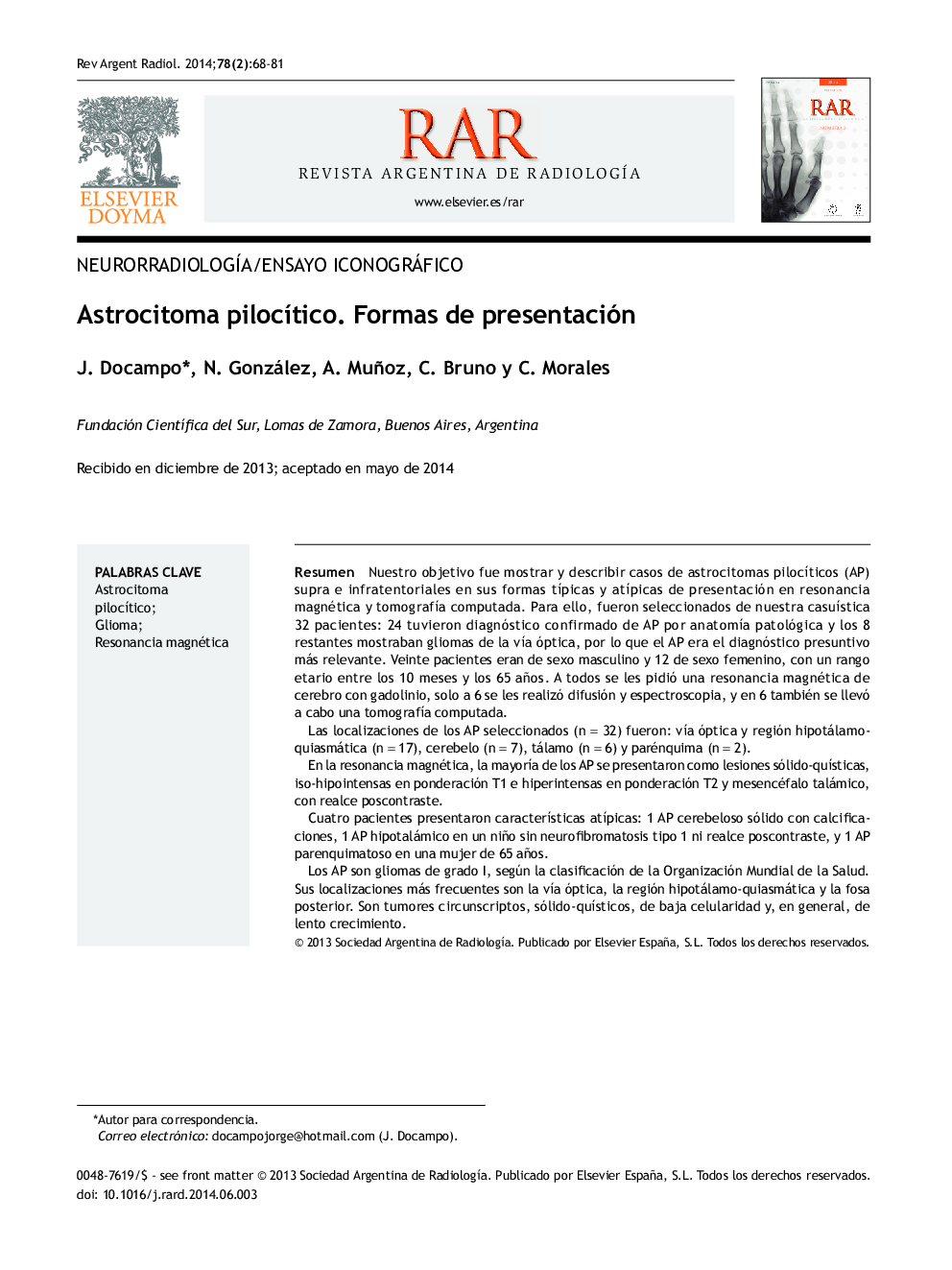| Article ID | Journal | Published Year | Pages | File Type |
|---|---|---|---|---|
| 4248719 | Revista Argentina de Radiología | 2014 | 14 Pages |
ResumenNuestro objetivo fue mostrar y describir casos de astrocitomas pilocíticos (AP) supra e infratentoriales en sus formas típicas y atípicas de presentación en resonancia magnética y tomografía computada. Para ello, fueron seleccionados de nuestra casuística 32 pacientes: 24 tuvieron diagnóstico confirmado de AP por anatomía patológica y los 8 restantes mostraban gliomas de la vía óptica, por lo que el AP era el diagnóstico presuntivo más relevante. Veinte pacientes eran de sexo masculino y 12 de sexo femenino, con un rango etario entre los 10 meses y los 65 años. A todos se les pidió una resonancia magnética de cerebro con gadolinio, solo a 6 se les realizó difusión y espectroscopia, y en 6 también se llevó a cabo una tomografía computada.Las localizaciones de los AP seleccionados (n = 32) fueron: vía óptica y región hipotálamo-quiasmática (n = 17), cerebelo (n = 7), tálamo (n = 6) y parénquima (n = 2).En la resonancia magnética, la mayoría de los AP se presentaron como lesiones sólido-quísticas, iso-hipointensas en ponderación T1 e hiperintensas en ponderación T2 y mesencéfalo talámico, con realce poscontraste.Cuatro pacientes presentaron características atípicas: 1 AP cerebeloso sólido con calcificaciones, 1 AP hipotalámico en un niño sin neurofibromatosis tipo 1 ni realce poscontraste, y 1 AP parenquimatoso en una mujer de 65 años.Los AP son gliomas de grado I, según la clasificación de la Organización Mundial de la Salud. Sus localizaciones más frecuentes son la vía óptica, la región hipotálamo-quiasmática y la fosa posterior. Son tumores circunscriptos, sólido-quísticos, de baja celularidad y, en general, de lento crecimiento.
Our purpose is to illustrate and describe the typical and atypical imaging findings of supra and infratentorial pilocytic astrocytoma (PA) with computed tomography (CT) and magnetic resonance imaging (MRI). For this, 32 patients with PA from our case series were selected. Twenty-four patients had confirmed PA from histologic analysis. The remaining 8 patients presented optic pathway gliomas and PA was the most accurate presumptive diagnosis. All patients, 20 male and 12 female (age range 10 months-65 years), underwent unenhanced and enhanced MRI. Diffusion-weighted images and MR spectroscopy (MRS) were performed in 6 patients, and 6 patients underwent CT.The locations of the PA selected (n = 32) were: optic pathway and hipotalamous-quiasmatic region (n = 17), cerebellum (n = 7), talamous (n = 6) and cerebral hemisphere (n = 2).At MRI most PA appeared as solid-cystic masses, iso to hypointense in T1-weighted images and hyperintense in T2-weighted images and FLAIR, with post-contrast enhancement.Four patients presented atypical characteristics: 1 solid cerebellum PA with calcifications, 1 hypothalamus PA in a child without NF1 with no contrast enhancement and 1 cerebral hemisphere PA in a 65 year old woman.The PA are regarded as grade I tumors in the WHO classification. The optic pathway and the hypothalamic-quiasmatic region, as well as the posterior fossa are the most frequent locations. PA are typically well-circumscribed and solid-cystic lesions with low cellularity and slow growth.
